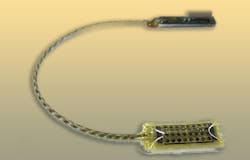Densely Packed Medical Electrode Reveals Details of Neural Behavior
Biomedical engineers at the Lawrence Livermore National Laboratory have developed a new way to make small, flexible neural electrodes. They used a 2.5-D printing process to create flat patterned layers of materials that are then etched into their final form. For their first electrode, the team used layers of polymers and metals.
This method lets many small, thin-film electrodes that are essentially identical to be made at once, which the team says should give the individual electrodes excellent consistency. This consistency should then make the electrodes more precise in sending and targeting different areas of the brain.
The thin-film electrode arrays also transmit higher-quality signals than their commercial counterparts, thanks to their flexibility which lets the electrodes make closer contact to the brain’s cortex. The flexibility also lets the array be molded into cylindrical shapes so it can be inserted into the brain. The array also has uniform stiffness due to the electrodes’ metal conductors being evenly distributed. In conventional electrode arrays, the wires are bundled, giving the array uneven and higher stiffness which prevents them from lying closely to the brain’s surface.
The team built a prototype. It houses 32 electrodes, each 1.2 mm in diameter and 2 mm apart. The thin-film arrays’ flexibility and size would let researchers add dozens more electrodes, and the manufacturing and assembly processes shows great promise for constructing customizable electrodes that target specific area of the brain for clinical and research applications, including intracranial stimulation.
To test the new electrodes to conventional ones, the research team used both to collected data from four patients about to undergo brain surgery to treat epilepsy. Results showed that even with electrodes only 2 mm apart, each one picked up unique information, meaning that electrodes could be more closely spaced to get more information or tighter control over the spatial spread of stimulation. Current electrodes used for diagnostics and therapeutic stimulation are limited by their large size (and corresponding lower density) of commercial electrodes.

